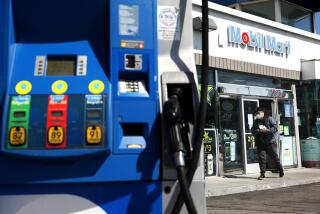Is it time to lift the 40-year-old ban on U.S. crude oil exports?
The story of the Arab oil embargo of 1973, with its high gasoline prices and long car lines at service stations, is a distant memory at best, a tale told by parents and aging relatives. Almost two-thirds of all Americans alive today were toddlers then or had not been born.
The legacy of that all-but-forgotten episode in the nation’s history has triggered a new, little-noticed partisan political battle in Washington — a fight to lift the 40-year-old restriction on U.S. crude oil exports imposed as a result of the embargo.
Today, pump prices in the U.S. are at multiyear lows. New discoveries and techniques for extracting crude from oil shale have dramatically reversed the long decline in U.S. petroleum production and promise more domestic crude output for years to come.
U.S. crude production this year is projected to average 9.3 million barrels a day, up more than 80% from the low point of just over 5 million in 2007 and 2008, according to the U.S. Department of Energy. America’s net imports of crude oil, meanwhile, are forecast to fall to nearly 6.8 million barrels a day this year from 9.2 million five years ago.
Large oil companies insist that it’s time to lift the restrictions on U.S. exports.
Since last year, oil companies have spent millions of dollars lobbying Congress and arguing in ads for a complete loosening of oil exports, now limited to petroleum products and crude shipments to Canada. Backers say that exporting crude would help the American economy by boosting oil production — and jobs — and allow the U.S. to support oil-starved allies around the world.
This fall the House voted 261-159, largely along party lines, to lift the ban. But the measure faces a tougher test in the Senate, where some Republicans are now trying to attach the legislation to a larger spending bill.
President Obama has indicated that he would veto the bill. The White House said that it is “not needed at this time” and that Congress should instead be “focusing its efforts on supporting our transition to a low-carbon economy.”
The president recently rejected a GOP-led push to approve construction of the controversial Keystone XL oil pipeline project from Canada, a decision praised by environmentalists as a significant victory in the fight against global warming. Obama has made tackling climate change a central part of his legacy, pledging to aggressively reduce carbon emissions by 2025 and taking a leadership role at the climate change conference in Paris this week.
Environmentalists worry that lifting the export ban could lower oil prices and thus boost consumer demand — and also carbon emissions.
With the public increasingly convinced that global warming is real, Democrats in Congress would be hard-pressed to break ranks with Obama and side with what opponents see as a giveaway to big oil companies.
Also opposing a change in the nation’s oil export policy are a clutch of American oil refineries, which have benefited from a market in which limited processing capacity for certain types of crude has given them leverage to demand discounts from domestic petroleum producers.
A central question in the battle: What would lifting the ban on exports mean for consumers?
Refineries argue that retail gasoline prices would go up as more domestic crude is shipped abroad, leaving less supply at home. But most experts say gasoline prices would be unchanged or drop slightly after export restrictions are removed because increased production would add to the world’s supply — and oil is priced in international markets.
A study published this year by Columbia University’s Center on Global Energy Policy estimated that lifting the current export ban would boost U.S. crude production as much as 1.2 million barrels a day, on average, from now to 2025. That in turn would reduce domestic gasoline prices up to 12 cents a gallon, the study estimated.
NEWSLETTER: Get the day’s top headlines from Times Editor Davan Maharaj >>
Regardless of export restrictions, the outlook for domestic crude production and oil prices remains highly uncertain.
“This is a particularly challenging moment because we don’t know how OPEC behavior will evolve,” said Trevor Houser, a Rhodium Group analyst and coauthor of the Columbia study with Jason Bordoff.
Saudi Arabia and other members of the Organization of the Petroleum Exporting Nations still account for the bulk of the world’s crude oil. To the surprise of some analysts, OPEC has released a steady flow of crude in the last 18 months even as global demand has weakened and increasing production in the U.S. has added to a global glut, resulting in downward pressure on prices.
In recent years, wind, solar and natural gas have become significant energy sources. Items as varied as cars and washing machines use less energy, all of which has helped reduce American consumption of oil from its peak in 2005.
But domestic oil use has crept higher the last three years as gasoline prices have fallen. The nationwide average price for regular gas was $2.09 a gallon on Thanksgiving week, very close to a decade low, excluding the Great Recession in 2008-09.
For now, global crude prices are at such low levels — less than $50 a barrel — that they have discouraged new oil development investments and production in the U.S. But when prices rise and companies respond by pumping more shale oil, that is likely to squeeze U.S. refining capabilities and result in less energy investment and economic activity.
Almost all of the growth in domestic crude output in recent years has come from extracting a type of light oil from shale deposits. But while the U.S. has sophisticated refining operations, particularly in the Gulf Coast, they are largely outfitted to process a heavier-weight oil, such as the kind imported from Canada and Venezuela. That has forced petroleum producers to offer discounts to refineries to process light oil.
New export markets would enable oil producers to fetch higher prices by selling crude to refineries abroad. Some analysts fear that oil companies would ship crude to northwest Europe to be processed. Shipping costs are less than what it would cost to transport the oil by rail from the Great Plains to the Northeast, said Jay Hauck, spokesman for a coalition of refineries operating mostly in the East Coast.
“That can undercut the East Coast refineries, where you’d make [the market] captive to the Europeans,” said Hauck, who contended that lifting the ban would make Americans more dependent on foreign oil.
For California, the effect of ending export restrictions is likely to be small, at least in the foreseeable future. The state produces about 650,000 barrels of crude oil a day, the third most in the country after Texas and North Dakota. Almost every drop gets processed in California’s 13 refineries, said Tupper Hall, a spokesman for Western States Petroleum Assn. in Sacramento. None of that is likely to be exported.
Nor is freeing oil exports, in itself, expected to spur much more petroleum production in the state. The biggest potential is in the Monterey Formation along the coast, the largest known source of shale oil reserves in the state. But regulatory, technical and economic constraints in exploiting it go far beyond any export restrictions, Hall said. Consequently, the Western States Petroleum Assn. hasn’t taken a position on the bill.
Even so, free-market advocates said the export restriction has created an economically irrational world with bizarre distortions. “It’s acted as a kind of subsidy for oil refineries of U.S. light-type of oil,” said Arthur Herman, a senior fellow at the Hudson Institute, a conservative think tank in Washington.
What’s more, he noted, the export ban already has an exemption for Canada, where the U.S. is shipping more than half a million barrels of crude a day. And this summer the U.S. agreed to allow some light oil exports to Mexico.
Still, given the economics of current low oil prices, which have slowed domestic production and with it any immediate challenge of how to handle a surplus of light oil, the urgency to lift the ban has diminished, Columbia University’s Bordoff said.
But, he noted: “You don’t know how quickly prices can turn around.”
ALSO
U.S. car sales soar as VW’s plunge
Mark Zuckerberg and Priscilla Chan pledge to donate 99% of their Facebook shares
Thanks to Google, now you can watch 360-degree videos of ballets, operas and symphonies







